
The fishing industry is undeniably one of the most demanding and hazardous professions globally. Workers face unpredictable seas, heavy machinery, and long hours, making Occupational Safety and Health (OSH) – or Keselamatan dan Kesehatan Kerja (K3) as it's known in Indonesia – not just a regulatory requirement, but a lifeline. Ensuring the well-being of fishing crews requires a multi-faceted approach, from comprehensive training and proper equipment to a deeply ingrained safety culture and adherence to national and international standards.
Let's dive into the key aspects that underpin safety on board fishing vessels:
1. Mandatory K3 Training: The First Line of Defense
Knowledge is power, especially when it comes to safety.
- Comprehensive Training: It's mandatory for all crew members to undergo K3 training. This isn't just a formality; it's crucial for raising awareness and equipping individuals with the ability to perform their duties according to established safety standards.
- Core Competencies: Training typically covers a wide range of critical areas, including emergency procedures (like man overboard or abandon ship drills), first aid administration, general health and hygiene practices at sea, and the proper use of safety equipment.
2. K3 Equipment: The Tools for Survival
A well-trained crew needs the right tools to manage risks effectively. Vessels must be equipped with adequate and well-maintained safety gear. This includes, but is not limited to:
- Fire extinguishers
- Life jackets for every crew member
- Comprehensive first aid kits
- Safety gloves and safety boots
- Ring buoys
- Reliable communication radio
- Automatic Identification System (AIS) for vessel tracking and collision avoidance
- Global Positioning System (GPS) for navigation
3. Cultivating a Safety Culture: Beyond Compliance
Rules and equipment are vital, but a genuine safety culture is what truly transforms a vessel's working environment.
- Shared Responsibility: This involves everyone on board actively prioritizing safety. Key elements include consistently wearing appropriate safety attire (helmets, gloves, boots, etc.), maintaining a clear and fair division of watch duties to prevent fatigue, and upholding high standards of hygiene to prevent illness.
- Avoiding Risky Behaviors: A strong safety culture also means actively discouraging and preventing risky behaviors, such as the consumption of alcohol or drugs while on duty, which can severely impair judgment and reaction times.
4. Regulatory Compliance: Navigating the Legal Waters
Adherence to established regulations is fundamental for ensuring a baseline standard of safety.
- National Regulations (Indonesia Example): In Indonesia, regulations like the Peraturan Menteri Kelautan dan Perikanan Nomor 42 Tahun 2016 (Ministry of Marine Affairs and Fisheries Regulation No. 42 of 2016) concerning Sea Work Agreements for Fishing Vessel Crews play a vital role. This regulation often stipulates requirements for OSH equipment and working conditions. National regulations can vary based on vessel category (length, tonnage, engine power, operational range), and certification regarding safety and manning is typically required.
- Government Initiatives: Efforts often include government-led education, training, and counseling programs in the fisheries sector to bolster safety awareness and practices.
5. Adherence to International Conventions and Guidelines
The maritime world is global, and so are the efforts to protect its workers. Several international conventions and guidelines set the standards for safety on fishing vessels:
- STCW-F 1995 (International Convention on Standards of Training, Certification and Watchkeeping for Fishing Vessel Personnel): This is a cornerstone convention establishing minimum knowledge and skill requirements for the certification of crews on seagoing fishing vessels of 24 meters in length or more. It covers crucial areas like emergency procedures, elementary first aid, prevention of marine pollution, and the prevention of shipboard accidents.
- ILO Work in Fishing Convention, 2007 (C188): This comprehensive convention addresses a broad spectrum of labor conditions, including minimum age for work, hours of rest, crew lists, medical examinations, onboard accommodation, food and water quality, and specific occupational safety and health measures. It mandates that fishing vessel owners ensure their vessels are operated safely and that crews receive adequate rest to prevent fatigue-related accidents.
- Torremolinos Convention for the Safety of Fishing Vessels (SFV), 1977 (and its 1993 Protocol): This convention applies to new fishing vessels of 24 meters in length and over, setting standards for their construction and equipment. Certain chapters have different applicability for vessels less than 45 meters.
- Code of Safety for Fishermen and Fishing Vessels (FAO/ILO/IMO): This code provides detailed practical guidance on the design, construction, and equipment of fishing vessels to enhance safety.
- Voluntary Guidelines for the Design, Construction, and Equipment of Small Fishing Vessels (IMO): Recognizing that many fishing vessels are under 24 meters, these guidelines offer specific safety recommendations for smaller craft.
- COLREGs (Convention on the International Regulations for Preventing Collisions at Sea, 1972): Essential for all mariners, COLREGs provide the "rules of the road" to prevent collisions at sea, a critical aspect of navigational safety.
6. Addressing Common Hazards and Enhancing Training
Understanding common risks is key to preventing them.
- Typical Dangers: Fishing operations are fraught with hazards such as vessel sinking or capsizing, injuries sustained during net hauling or other fishing operations, dangers associated with overloading the vessel, and the ever-present risk of drowning.
- Targeted Training Needs: Training must specifically address these risks, often focusing on risk awareness, basic life support (BLS), advanced first aid, and survival techniques.
- Persistent Issues: Common problems contributing to accidents include a lack of regular vessel safety checks, failure to use life jackets consistently, overloading vessels beyond their capacity, and a generally low understanding or prioritization of OSH principles among some crews.
7. Modern Aspects and Evolving Challenges
While the core principles of maritime safety remain, the "modern" context brings new considerations:
- Technological Aids: Modern safety equipment like AIS and GPS, already mentioned, significantly contribute to navigational safety and emergency response.
- Human Rights and Labor Conditions: There's an increasing global focus on human rights within the fishing industry. This includes the urgent need for training and systems to address and prevent issues like forced labor. Ensuring that fishery products meet international market demands now often includes scrutiny of labor rights and conditions onboard.
Safety at sea is not an option; it's a necessity. A comprehensive approach that integrates rigorous training, appropriate equipment, a strong safety culture, and unwavering compliance with both national and international regulations is essential to protect the lives of those who work tirelessly to bring seafood to our tables. Continuous improvement and adaptation to new challenges are key to making the fishing industry safer for everyone involved.

